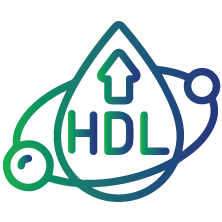
HOMA IR (Insulin Resistance) Test
HOMA IR (Insulin Resistance)
Insulin is a hormone that regulates your blood sugar levels (glucose). Insulin resistance occurs when the body's cells become less responsive to this hormone. As a result, people with insulin resistance may have elevated blood sugar levels, putting them at risk of developing diabetes in the future.
HOMA (Homeostatic Model Assessment of Insulin Resistance) is a robust method for estimating a person's risk of developing diabetes by assessing their beta cell function (insulin production and secretion) and insulin resistance. Health care providers use this test to determine the likelihood of a person developing diabetes.
Who should get tested?
It is indicated in individuals who are:

It is indicated in individuals who are:

Hypertensive (High Blood pressure)

High cholesterol
Test preparation:
Your healthcare provider will collect the fasting blood sample by inserting a needle into a vein in your arm. A fasting state of about 8-12 hours is recommended prior to the test to ensure the accuracy of the test results
Interpretation of results
Results are usually displayed against a HOMA IR scale that determines the level of your insulin resistance. The higher your HOMA-IR gets, the more resistant you are to insulin.
|
Scale values |
Indication |
|
<1 |
Normal |
|
1.9 |
Optimal insulin sensitivity |
|
2.9 |
High insulin sensitivity |
Low or normal HOMA IR indicates that you are insulin sensitive, which means that the insulin produced normally by the pancreas is sufficient to keep your blood sugar levels normal.
High HOMA IR may indicate insulin resistance, which means that your body is using more insulin than normal in order to keep your blood sugar levels in normal ranges, thereby increasing the risk of developing diabetes in the near future
FAQs
What is the turnaround time (TAT) for HOMA IR?
The test results for HOMA IR are usually available within 2 – 3 working days after the sample collection. However, it could also take a little longer at times
Are there any risks associated with the HOMA IR test?
No, there are no potential risks associated with the HOMA IR test. However, all blood tests involve negligible risks, such as feeling a slight sting or bruise at the site of sample collection. It usually goes away within a few minutes to several hours
Is insulin resistance a reversible condition?
Yes, insulin resistance in its optimal range could be reversible. Insulin resistance can lead to several metabolic disorders, such as diabetes mellitus, hypertension, cardiovascular disease, and high cholesterol. Therefore, it is very essential to manage insulin resistance to avoid the risk of diabetes.
The HOMA IR index provides accurate information on how well your body regulates blood sugar levels. If the results are in the optimal insulin resistance range, it can be managed with diet, exercise, weight loss, and, if necessary, medications
Are there any warning signs of insulin resistance?
Yes, you may experience a few signs and symptoms of insulin resistance. You may get tested for HOMA IR if you see any of the following:
· Extreme thirst or hunger
· Frequent urination
· Tingling sensation in the hands and legs
· Frequent infections
· Feeling hungry even after a meal
· High blood sugar than normal in blood work
Insulin resistance is also a great risk in conditions such as being overweight or obese, having high cholesterol, having heart disease, or having high blood pressure.
Can I undergo the HOMA IR test if I am in 4 hours of fasting state?
No. HOMA IR is a blood test that must be taken after a fast of at least 8-12 hours. Anything less than this time limit may impact the accuracy of the test results

